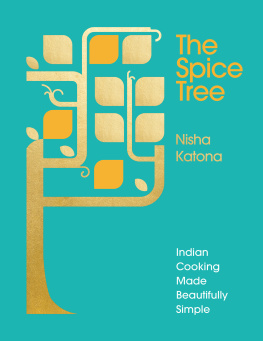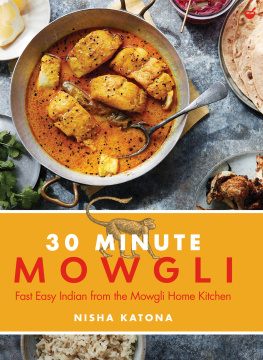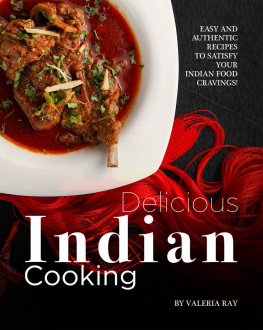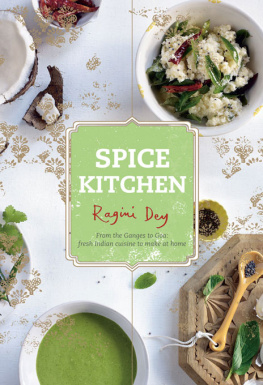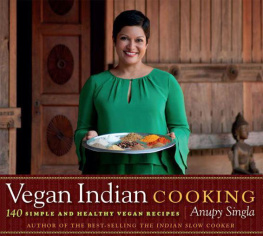CONTENTS
To my roots and my branches
Maa, Monmon, India, Tia, Shona,
Mirren and Nayan.
Preface
It is a little known truth that many of the Indians who left for the West came from homes that hired chefs. By virtue of the fact that one could afford a ticket to the West, it often followed that one had enough money for a phalanx of servants. Many first-generation Indians that came to the UK did not have the cooking skills of their ancestors. It is also a sad truth that the mothers and grandmothers who started our lives with their spice formulas and kitchen secrets will take many of those culinary arts to their graves.
These two points, in part, led me to write this book. I, too, will pass and there is little I can leave for my daughters of their ancient heritage. However, the Indian kitchen spice formula is one thing that I can articulate and enshrine in written form. This is something that they can open like a book of spells, or prayers, and conjure the taste of their mothers love, the smell of their grandmothers kitchen, the ferocity of flavour of nights around the home fires.
My attempts to articulate the spice formula, in a way that makes sense to anyone wanting to cook like an Indian, grew into the infographic at the heart of this book, the Spice Tree. It is a kind of flow chart that maps the neural pathways of an Indian cook.
The main aim of this book, for any reader, is to become a go-to, kitchen shelf, spice Sherpa. It is not a recipe book that slavishly shackles one to the written word, but rather aims to liberate by revealing the ancient, tried-and-tested spice formulas that are second nature to billions.
This book will help anyone master spices and understand why they work with some ingredients and not others; to create the perfect authentic curry every time; and also to apply the spice formula to everyday ingredients to tease different and exciting dimensions out of the ordinary.
The aim of the Spice Tree is to be a quick reminder of the formulas always at play in the Indian kitchen; to lay out the systematic routes you should always take.
The spices and finishing flavours used in Indian cuisine are not unusual. They will be familiar to you. Many of the ingredients that you need will already be lurking, untroubled for months, in your cupboards. This book will breathe new life into those ingredients, those that you might want to cook, but are afraid to approach.
What I find so wonderful about the Indian spice formula is the way that the most humble and lacklustre ingredients become the most exciting and flavourful dishes in minutes. Never again will you look at a packet of lentils or chickpeas and sigh the lament of the unworthy. You will understand why ingredients like the meagre Savoy cabbage become king in the Indian kitchen. Indian spice formulas draw magic out of these robust, deep, chlorophyll-rich jewels of the vegetable garden.
How to Use the Spice Tree
The Spice Tree maps out the ingredients you generally need to cook all Indian cuisine.
What are you cooking? Potatoes? Trout? Lentils? Chicken? Locate the colour coded root system appropriate to your main ingredient.
Green = all vegetables
Blue = fish and shellfish
Yellow = pulses (both light and heavy)
Red = meat (including poultry and eggs)
The starter root balls are your options for the base or headnote flavour for the dish. In the trunk youll find turmeric, chilli powder, salt and sugar all essential additions to every dish you cook and which should always be added according to your taste. As you reach the branches you find the range of appropriate finishing flavours. It is here that you can dream up your own combinations, adding as many as you like, working within tried-and-tested parameters, to tailor the finished curry to your taste.
Follow the 4 steps shown on the Spice Tree whenever you want to cook like an Indian, starting at the roots and flowing up through the tree to the leaves.
Step 1: Pick ONE starter ball from the root system and fry it awake in a pan with a little oil. See for a key to the starter balls.
Step 2: Add your main ingredient the veg, fish, pulses or meat and toss it into the pan with the fried base spices.
Step 3: Now travel up the trunk and add turmeric and chilli, the mother and father of all curry. Season with salt and sugar to taste.
Step 4: Follow the branch, sticking with the same colour. Choose one or more of the ingredients in the leaves to finish your dish. Play around and have fun this is how you personalise your curry.
At the start of each chapter, youll find a simplified version of the tree for that kind of main ingredient to act as a concise reminder wherever you are in the book.
A key to the starter balls
The starter balls are tried-and-tested age-old combinations. For example, South Indians always start with a certain combo, or meat dishes are always started with onion, ginger and garlic (see more about this ). I have given these combinations nicknames on the Spice Tree and throughout the book with the aim of making them easier to remember. When you see these names, they always call for the following ingredients to be fried together in a little oil.
Gujrati Quartet:
Mustard Seed, Dried Red Chilli, Cumin Seed and Asafoetida (to vitalise vegetarian dishes)
Nuclear Duo:
Fenugreek Seed and Asafoetida (when cooking lacklustre vegetables)
South Indian Trio:
Mustard Seed, Dried Red Chilli and Curry Leaf
Meat Mantra:
Onion, Ginger, Garlic (as much as you can be bothered to chop, then fry into a golden sweet mass)
Meat-Veg Marriage:
Any fried seed spice followed by Onion, Ginger, Garlic (for main ingredients considered to be a hybrid of meat and vegetable, e.g. chickpeas, kidney beans or all fish)
Two Ancient Alliances:
Nigella Seed & Green Chilli (pierce the green chilli and fry whole with nigella seed. Green chilli is the fresh antidote to earthy nigella)
Mustard Seed & Dried Red Chilli (the umami flavour added by frying dried red chilli complements the nutty warmth of the fried mustard seed)
Introduction
It is said of Bengali Indians that they are only concerned with three things in life: food, books and educating their children. As distant as I thought I was from this maxim, the older I get, the more I find the joys of my life have in fact distilled down to those three clichd comforts.
My parents came to Britain in the 1960s as doctors and it was into a working class, gritty, northern town that I was born and raised. Some of my earliest memories are of bricks through windows and racist graffiti. My mother tells of being taunted in the streets by the very people she would then see as patients.

